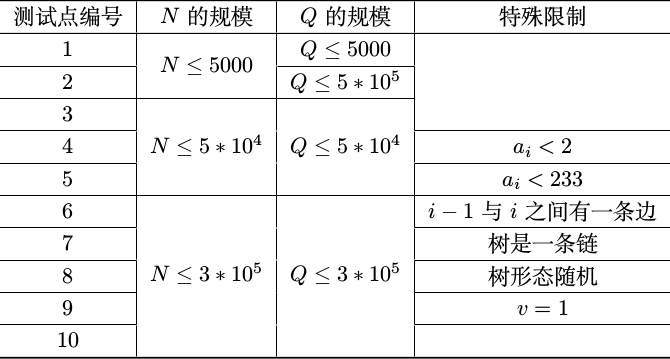题目传送门(内部题152)
输入格式
第一行两个整数$N,Q$。
接下来一行$N$个整数,第$i$个为$a_i$。
接下来的$N-1$行,每行两个整数$u,v$。表示$u,v$之间有一条边。
接下来的$Q$行,每行两个整数$u,v$。表示一组询问。
输出格式
对于每个询问,输出一行一个整数表示答案。
样例
样例输入:
5 2
4 3 2 5 3
1 2
1 3
3 4
3 5
2 5
3 4
样例输出:
13
7
数据范围与提示
每个测试点10$分,共$10$个测试点:

对于所有的数据,有:$1\leqslant N,Q,0\leqslant a_i<323232323$
题解
题目没多难,用倍增维护父亲,每一位的前缀和,向上的答案即可。
我的打法跟正解不太一样,被卡空间了$\downarrow$

不过结果还是好的啦~

说来也神奇,晚上做了个梦,突然想到了一种优化方式;早上过来没多久就$A$啦,真的是做梦都在码代码。
时间复杂度:$\Theta(n\log n)$.。
期望得分:$100$分。
实际得分:$100$分。
代码时刻
#include<bits/stdc++.h>
#define int int_least32_t
using namespace std;
struct rec{int nxt,to;}e[600001];
struct node{int x,y,lca;}q[300001];
int head[600001],cnt;
int N,Q;
int a[600001];
int depth[600001],fa[600001][21];
pair<int,short> c[21];
int_least64_t val[600001][21],up[600001][21],ans[300001];
void dfs(int x)
{
for(int i=head[x];i;i=e[i].nxt)
{
if(depth[e[i].to])continue;
depth[e[i].to]=depth[x]+1;
fa[e[i].to][0]=x;
up[e[i].to][0]=a[e[i].to];
for(short j=1;j<21;j++)fa[e[i].to][j]=fa[fa[e[i].to][j-1]][j-1];
for(short j=0;j<21;j++)val[e[i].to][j]=val[x][j]+((a[e[i].to]&(1<<j))>0);
for(short j=1;j<21;j++)up[e[i].to][j]=up[e[i].to][j-1]+up[fa[e[i].to][j-1]][j-1]+1LL*(1<<(j-1))*((1<<(j-1))-val[fa[e[i].to][j-1]][j-1]+val[fa[e[i].to][j]][j-1]);
dfs(e[i].to);
}
}
void dfs(int x,int fat)
{
for(int i=head[x];i;i=e[i].nxt)
{
if(e[i].to==fat)continue;
up[e[i].to][0]=a[e[i].to];
for(short j=1;j<21;j++)up[e[i].to][j]=up[e[i].to][j-1]+up[fa[e[i].to][j-1]][j-1]+1LL*(1<<(j-1))*((1<<(j-1))-val[e[i].to][j-1]+val[fa[e[i].to][j-1]][j-1]);
dfs(e[i].to,x);
}
}
int get(int x,int dep){for(short i=0;i<21;i++)if(dep&(1<<i))x=fa[x][i];return x;}
int LCA(int x,int y)
{
if(depth[x]>depth[y])swap(x,y);
for(short i=20;i>=0;i--)
if(depth[fa[y][i]]>=depth[x])y=fa[y][i];
if(x==y)return x;
for(short i=20;i>=0;i--)
if(fa[x][i]!=fa[y][i])
{x=fa[x][i];y=fa[y][i];}
return fa[x][0];
}
long long ask1(int x,int y)
{
if(x==y)return 0;
long long res=0;
for(short i=19;i>=0;i--)
if(depth[fa[x][i]]>=depth[y])
{
res+=up[x][i];
x=fa[x][i];
res+=(depth[x]-depth[y]-(val[x][i]-val[y][i]))*(1<<i);
}
return res;
}
long long ask2(int x,int y)
{
if(x==y)return a[x];
if(depth[x]>depth[y])return 0;
short top=0;
long long res=0;
int now=y;
for(short i=0;i<21;i++)
if((depth[y]-depth[x]+1)&(1<<i))
{
c[++top]=make_pair(now,i);
now=fa[now][i];
}
for(short i=top;i;i--)
{
res+=up[c[i].first][c[i].second];
if(c[i].second)
res+=1LL*(1<<(c[i].second))*(depth[y]-depth[c[i].first]-(val[y][c[i].second]-val[c[i].first][c[i].second]));
}
return res;
}
int main()
{
scanf("%d%d",&N,&Q);
for(int i=1;i<=N;i++)scanf("%d",&a[i]);
for(int i=1;i<N;i++)
{
int x,y;
scanf("%d%d",&x,&y);
e[++cnt]=(rec){head[x],y};head[x]=cnt;
e[++cnt]=(rec){head[y],x};head[y]=cnt;
}
depth[N<<1]=1;
for(int x=N<<1;x>N+1;x--)
{
depth[x-1]=depth[x]+1;
fa[x-1][0]=x;
for(short j=1;j<21;j++)fa[x-1][j]=fa[fa[x-1][j-1]][j-1];
}
depth[1]=depth[N+1]+1;
fa[1][0]=N+1;
up[1][0]=a[1];
for(short j=1;j<21;j++)fa[1][j]=fa[fa[1][j-1]][j-1];
for(short j=0;j<21;j++)val[1][j]=val[N+1][j]+((a[1]&(1<<j))>0);
for(short j=1;j<21;j++)up[1][j]=up[1][j-1]+up[fa[1][j-1]][j-1]+1LL*(1<<(j-1))*((1<<(j-1))-val[fa[1][j-1]][j-1]+val[fa[1][j]][j-1]);
dfs(1);
for(int i=1;i<=Q;i++)
{
scanf("%d%d",&q[i].x,&q[i].y);
q[i].lca=LCA(q[i].x,q[i].y);
ans[i]=ask1(q[i].x,q[i].lca);
}
up[1][0]=a[1];
for(short j=1;j<21;j++)up[1][j]=up[1][j-1]+up[fa[1][j-1]][j-1]+1LL*(1<<(j-1))*((1<<(j-1))-val[1][j-1]+val[fa[1][j-1]][j-1]);
dfs(1,0);
for(int i=1;i<=Q;i++)
{
int res=get(q[i].lca,depth[q[i].x]-depth[q[i].lca]);
printf("%lld\n",ans[i]+ask2(res,q[i].y)-ask2(res,fa[q[i].lca][0]));
}
return 0;
}
rp++